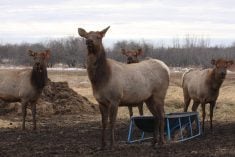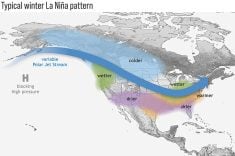Pronghorn antelope have a reputation for being fleet of foot.
It turns out they also go far afield.
Researchers in Alberta, Saskatchewan and Montana are jointly studying the habitat and migration patterns of pronghorn after early research found the animals routinely move through all three regions.
The jurisdictions together contain the world’s population, split about 30 percent in Canada and 70 percent in the United States, said Andrew Jakes, a University of Calgary PhD student working on the Northern Sagebrush Steppe Initiative.
Read Also

Canadian Food Inspection Agency extends chronic wasting disease control program consultation deadline
Date extended for consultation period of changes to CWD program
“They are unique to North America,” Jakes said of the small ungulate.
“I really think they can be an icon of the grassland.”
Over two million years, pronghorn have developed into the fastest mammal in North America, second in the world only to the cheetah.
They can reach speeds of 95 km-h and sustain 35 km-h for long periods of time.
At a height of about one metre and maximum weight of 52 kilograms, pronghorn can travel far on their bony legs. Alberta research has found an average annual migration of about 330 kilometres and up to about 800 km.
Jakes said millions of years of living on the prairie have created an animal highly adapted to the flat landscape. They can see danger coming from kilometres away.
It’s possible that prairie dwellers take pronghorns for granted, Jakes said, but they really are unique.
Over time their habitat has changed. Pronghorn were once common in Manitoba but are now just tourists, wandering in occasionally from Saskatchewan.
The last known Manitoba pronghorn was shot in 1881. It is illegal to hunt them there now.
In contrast, 18,000 to 19,000 live in Saskatchewan and 20,000 in Alberta.
The populations fluctuate due to weather and migration, said Paul Jones, a wildlife biologist at the Alberta Conservation Association (ACA).
The ACA, along with University of Calgary and the provincial government’s Alberta Fish and Wildlife Division, got the research ball rolling when they collared 24 does in December 2003. Another 25 were collared in both 2005 and 2006.
Jones said the GPS collars eventually drop off and are then gathered and the data analyzed. The idea was to study habitat use patterns in Alberta, but some of the collars were found in Montana and Saskatchewan.
A memorandum of understanding signed by all three jurisdictions in 2007 expanded the project.
“The idea was to start looking from an ecosystem perspective,” Jakes said.
In 2008, 22 does were collared just north of Malta, Mont., and four ended up in Saskatchewan.
This year, 20 were collared at Malta, 20 north of Glasgow, Mont., and nine just southwest of Shaunavon, Sask.
Saskatchewan Environment wildlife biologist John Pogorzelec said the Argos GPS system sends information every 14 days via satellite until the collar drops off in January.
That information will include the animal’s location as it was recorded every four hours.
Of the 40 Montana collars, about half are in Saskatchewan right now, Jakes said.
Pronghorn do move out of their typical range. In Saskatchewan, animals have been spotted just 20 km from the provincial forest, likely lured by good food and recent mild winters.
“They are completely out of their range,” Pogorzelec acknowledged.
These would be among the first to die in a harsh winter, he said, because they are too far away from the sagebrush they need at that time of year. Once the snow is deeper than 30 centimetres, they will begin to move.
Hunting has not kept the population in check and farmers may find pronghorn in their fields and feedstacks where they never did before.
Pogorzelec said that’s because of their ability to move great distances. For example, drought in their range around Leader and Kindersley has pushed them elsewhere.
Antelope like lentils and peas and will make trails through standing crop to get to these fields if necessary.
Pogorzelec also said farmers may see pronghorn in spring-planted fields until the crops are about half-mature. Then, they can’t see over the crop and will move into sloughs, fallow or pasture.
Farmers and ranchers can encourage pronghorns to pass through their fields by raising the bottom wire of their fences to at least 45 centimetres off the ground and replacing barbed with smooth wire.
Pronghorn can jump but are most often seen going under rather than over fences.
Highways, rail lines and other barriers cause the animals distress. One doe in Alberta spent 10 days trying to cross the Trans-Canada Highway.
Pasture managers can also help by leaving gates open in winter.
“The big key is the silver sagebrush,” Jones said. “They rely on it for winter. They have small hoofs and they’re not great at pawing through the snow.”
Jakes said this research is the start of a conservation network that could be important for other species because wildlife and economic needs must be satisfied.















